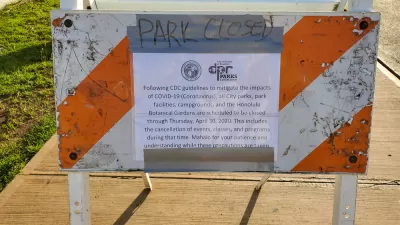Almost three months ago, President Trump announced "sometime today we’ll do a quarantine, short term, two weeks, on New York, probably New Jersey, certain parts of Connecticut" to prevent viral spread to Florida. On Wednesday, the roles reversed.

President Trump backed off the quarantine threat on March 28 and the Centers for Disease Control and Prevention issued a milder travel advisory instead.
The three Democratic governors from New York, New Jersey are more serious, with New York Gov. Andrew Cuomo stating the penalties for violations.
Travelers from Florida to New York, New Jersey, and all parts of Connecticut will not be the only ones required to quarantine for two weeks according to the Joint Incoming Travel Advisory announced Wednesday:
This quarantine - effective midnight tonight - applies to any person arriving from a state with a positive test rate higher than 10 per 100,000 residents over a 7-day rolling average or a state with a 10% or higher positivity rate over a 7-day rolling average.
In a joint press conference on Wednesday from Albany, with Govs. Lamont (Conn.) and Murphy (N.J) participating remotely, Cuomo identified the nine states that would be subject to quarantine requirements due to high "infection rates:"
- Alabama
- Arkansas
- Arizona
- Florida
- North Carolina
- South Carolina
- Utah
- Texas
- Washington ["After a further review of the data, it was dropped from the list," notes the source article.]
"That's as of today," added Cuomo. "The states themselves can change as the infection rate changes and we will update daily what states are above that infection rate."
"We live in the densest neighborhood in America; we've been clobbered by this virus; no region in the country has paid a bigger price," said Gov. Murphy in the 26-minute press conference accessible on YouTube as well as the advisory announcement. "We've lost just under 13,000 [people]." According to the New York Times coronavirus tracker, New York has lost 31,000 and Connecticut almost 4,300 to the coronavirus as of June 24.
New Yorkers returning from those high-infection states would also be subject to the quarantine, reports J. David Goodman for The New York Times (source article).
Mr. Cuomo said that enforcement would be up to each of the three states. In New York, he said, those violating the quarantine order could be “subject to a judicial order and mandatory quarantine.” A first violation could result in a $2,000 fine and could go up to $10,000 for subsequent violations.
Only a handful of states — including Maine, Rhode Island and Hawaii — have required out-of-state travelers to quarantine. A larger number have asked travelers to quarantine but do not mandate doing so. And a few, such as Florida and Kansas, apply the requirement only to those coming from certain states.
The joint advisory stems from a regional approach to respond to the virus formed by the three neighboring governors on March 16, the same day that seven Bay Area county public health officials issued the nation's first collective shelter-in-place order.
Test positivity rates
Coronavirus test positivity rates were described in a rather chilling post earlier this week about a new model projecting that Florida will be next U.S. coronavirus epicenter:
The World Health Organization advised governments on May 14 that before reopening, "rates of positivity in testing (i.e, out of all tests conducted, how many came back positive for COVID-19) should remain at 5% or lower for at least 14 days."
According to the John Hopkins University Coronavirus Resource Center testing hub, six states: Arizona, South Carolina, Florida, Utah, Mississippi, Texas, Florida and Puerto Rico fail the 10 percent threshold as of June 24. However, Hopkins uses a two-week rolling average, not the seven-day average in the tri-state quarantine. Infections have been soaring throughout the South and West this week, with "38,115 new infections reported by state health departments on Wednesday — surpassing the previous single-day record of 34,203 set on April 25," reports The Washington Post at 8:11 p.m. PDT.
Epidemiologists approve
"Epidemiologists do not see a uniform coronavirus wave spreading across the country, but multiple outbreaks that are out of sync with each other," adds Goodman. "In that context, they said, quarantine requirements made sense."
Related in Planetizen:
-
Model Predicts [Florida] Next U.S. Coronavirus Epicenter, June 22, 2020
-
The New Regionalism of the Coronavirus Pandemic, March 19, 2020
FULL STORY: N.Y. Will Impose Quarantine on Visitors From States With Big Outbreaks

Study: Maui’s Plan to Convert Vacation Rentals to Long-Term Housing Could Cause Nearly $1 Billion Economic Loss
The plan would reduce visitor accommodation by 25,% resulting in 1,900 jobs lost.

North Texas Transit Leaders Tout Benefits of TOD for Growing Region
At a summit focused on transit-oriented development, policymakers discussed how North Texas’ expanded light rail system can serve as a tool for economic growth.

Why Should We Subsidize Public Transportation?
Many public transit agencies face financial stress due to rising costs, declining fare revenue, and declining subsidies. Transit advocates must provide a strong business case for increasing public transit funding.

How to Make US Trains Faster
Changes to boarding platforms and a switch to electric trains could improve U.S. passenger rail service without the added cost of high-speed rail.

Columbia’s Revitalized ‘Loop’ Is a Hub for Local Entrepreneurs
A focus on small businesses is helping a commercial corridor in Columbia, Missouri thrive.

Invasive Insect Threatens Minnesota’s Ash Forests
The Emerald Ash Borer is a rapidly spreading invasive pest threatening Minnesota’s ash trees, and homeowners are encouraged to plant diverse replacement species, avoid moving ash firewood, and monitor for signs of infestation.
Urban Design for Planners 1: Software Tools
This six-course series explores essential urban design concepts using open source software and equips planners with the tools they need to participate fully in the urban design process.
Planning for Universal Design
Learn the tools for implementing Universal Design in planning regulations.
City of Santa Clarita
Ascent Environmental
Institute for Housing and Urban Development Studies (IHS)
City of Grandview
Harvard GSD Executive Education
Toledo-Lucas County Plan Commissions
Salt Lake City
NYU Wagner Graduate School of Public Service





























